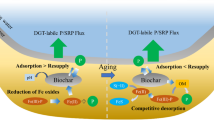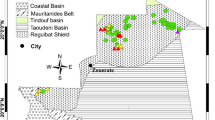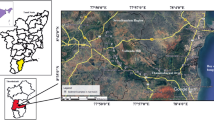Abstract
Relatively strongly magnetic fine components (< 30μm, XS-4J and DS-4J) which are most environmentally sensitive were separated from layer S5-1 in the Xifeng and Duanjiapo loess sections and analyzed by MPV-3 for their morphometric characteristics and reflectance, SEM-ESD for their element contents and XRD for their mineral phases, respectively. The results showed that minerals in both samples are dominated by detrial Fe-Ti oxides of aeolian origin. In sample XS-4J the reflectance and iron contents of magnetic minerals are usually high. In addition to magnetite (Fe3O4), maghemite (γFe2O3) and hematite (Fe2O3), some Fe-high oxide (72.25 wt%–86.67 wt%), ilmenite (FeTiO3), and magnetite-ulvöspinel [Fe(FeCr)O4, Fe (FeNi)O4] were also detected. In sample DS-4J obvious negative linear correlations were found between Ti and Fe, and the contents of Mn, Si, Al and Ca are usually high and the minerals are dominated by magnetite (maghemite), goethite (FeOOH) and limonite (containing Si and OH). In addition, the signs of corrosion of magnetic minerals and newly crystallized magnetite (maghemite) were recognized. Differences in the composition and assemblage characteristics of magnetite minerals between XS and DS reflect significant differences in source rocks and preserving conditions.
Similar content being viewed by others
References
Chen Zheng, Chen Dianfen, and Zou Xing, 1979, Research about the color indices of metallic mineral [M]: Beijing, Geological Publishing House, p. 92–103 (in Chinese).
Guo Bin, Zhu Rixiang, Bai Lixin et al., 2001, Rock magnetic properties of a loess-paleosol couple along on N-S transect in the Chinese Loess Plateau [J]: Science in China (Series D), v. 44, n. 12, p. 1099–1109.
Han Jiamao, Jiang Wenying, and Chu Jun, 1997, Size distribution of magnetic minerals in loess and paleosol [J]: Quaternary Research, v. 3, p. 281–287 (in Chinese with English abstract).
Institute of Geology and Mineral Resources, 1978, Identify of metallic mineral by microscopy [M]: Beijing, Geological Publishing House, p. 267–590 (in Chinese).
Jia Rongfen, Zhou Zheng, Luo Liqung et al., 2003, A method of enriching micrometer-grade magnetic minerals in Chinese loess [J]: Geochimica, v. 1, p. 97–101 (in Chinese with English abstract).
Jimim, S. and L. Tungsheng, 2000, Multiple origins and interpretation of the magnetic susceptibility signal in Chinese wind-blown sediments [J]: Earth and Planetary Science Letters, v. 180, p. 287–296.
Li Shuanglin, Li Shaoquan, and Meng Xiangjun, 2002, Chemical composition and source tracing of Late Quaternary sediments in the East China Sea Shelf Marine [J]: Geology & Quaternary Geology, v. 4, p. 21–28.
Liu Tungsheng and Zhang Zonghu, 1962, Chinese loess [J]: Scientia Geologica Sinica, v. 42, n. 2, p. 1–14 (in Chinese with English abstract).
Pan Zhaolu, 1985, Crystallography and mineralogy (Volume II) [M]: Beijing, Geological Publish House, p. 50–90 (in Chinese).
Peng Xianzhi, 2000, Paleoclimatic information as recorded in microbes and organic matter in Chinese loess—Studies of the contributions to the magnetic susceptibility of magnetotactic bacteric and the characteristic biomarkers [D]: Ph. D. Thesis of Guangzhou Institute of Geochemistry, Chinese Academy of Science, Guangzhou, p. 17–30 (in Chinese with English abstract).
Ren Qijiang, 1991, Research on Ti-Fe oxide in igneous and its mineral deposits [M]: Beijing, Science Press, p. 1–73 (in Chinese).
Sun Shaohua, 1995, Research on the thermal evolution and oil-gas accumulation in basin controlling by structural—As an example in Ordos [D] : Ph. D. Thesis of Guangzhou Institute of Geochemistry, p. 1–15 (in Chinese with English abstract).
The American Ceramic Society, 1993, Mineral power diffraction file databook (sets 1–42) [M]: Swarthmore, International Centre for Diffraction Data, p. 6–696.
Torii, M., T. Q. Lee, K. Fukuma et al., 2001, Mineral magnetic study of the Taklimakan desert sands and its relevance to the Chinese loess [J]: Geophys. J. Int., v. 146, p. 416–424.
Touloukian Y. S., W. R. Judd, and R. F. Roy, 1981, Physical properties of rocks and minerals, translated by San Jiazen and Li Jiniang, 1990 [M]: Beijing, Petroleum Industry Press, p. 235–254 (in Chinese).
Wang Luo, Liu Dongsheng, and Han Jiamaoet al., 2000, Environmental magnetism of Chinese Quaternary loess: a brief review [J]: Advance in Earth Sciences, v. 15, n. 3, p. 335–341 (in Chinese with English abstract).
Zheng Honghan, B. K. G. Theng, and J. S. Whitten, 1994, Mineral composition of loess and paleosol in the Loess Plateau and its environmental significance [J]: Geochimica, v. 23 (suppl.), p. 113–123 (in Chinese with English abstract).
Author information
Authors and Affiliations
Corresponding author
Additional information
This research project was financially supported jointly by the National Natural Science Foundation of China (Grant No. 40073029) and the Director’s Foundation of the Guangzhou Institute of Geochemistry, Chinese Academy of Sciences (No. A05-020501-4).
Rights and permissions
About this article
Cite this article
Rongfen, J., Xianzhi, P., Zheng, Z. et al. Composition and assemblage characteristics of magnetic minerals in layer S5-1 of Xifeng and Duanjiapo sections. Chin. J. Geochem. 23, 197–206 (2004). https://doi.org/10.1007/BF02842068
Issue Date:
DOI: https://doi.org/10.1007/BF02842068




